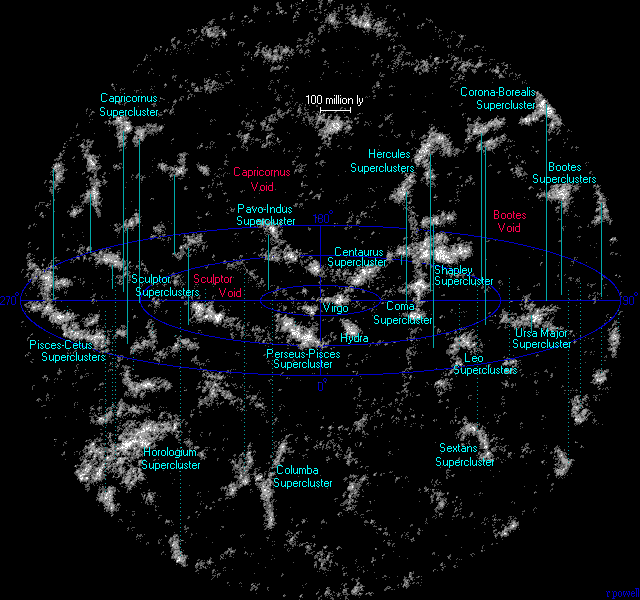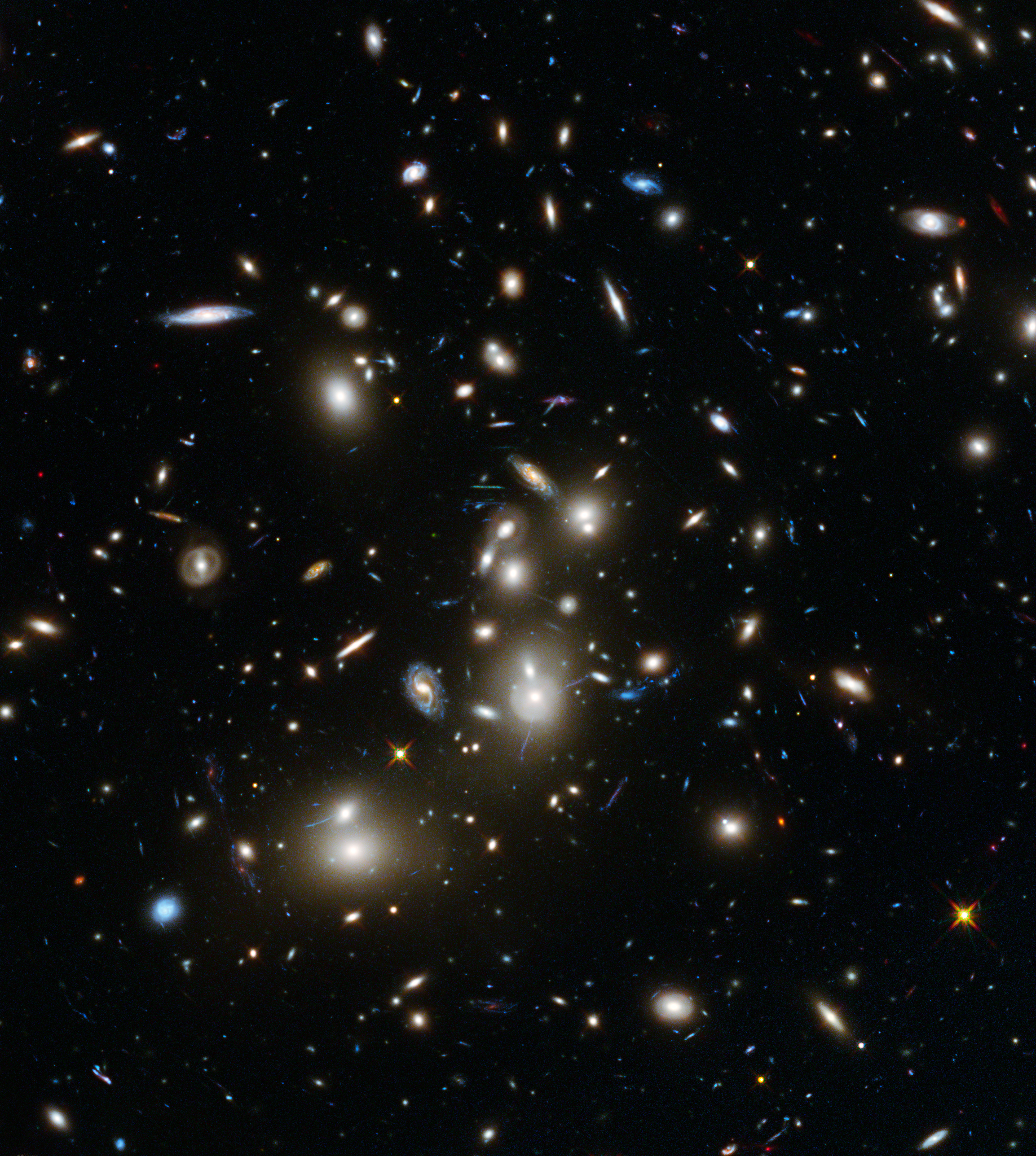|
Perseus–Pisces Supercluster
The Perseus–Pisces Supercluster (SCl 40) is one of the largest known structures in the universe. Even at a distance of 250 million light-years, this chain of galaxy clusters extends more than 40° across the northern winter sky. The Perseus-Pisces Supercluster is one of two dominant concentrations of galaxies (the other being the Local supercluster) in the nearby universe (within 300 million light years). This supercluster also borders a prominent void, the Taurus Void, and is part of the Perseus–Pegasus Filament which stretches for roughly a billion light years.'Astrophysical Journal', Part 1 (), vol. 299, Dec. 1, 1985, p. 5-14. "A possible 300 megaparsec filament of clusters of galaxies in Perseus-Pegasus" ''12/1985'' Clusters The main clusters of the Perseus–Pisces Supercluster are Abell 262, Abell 347, and Abell 426. See also * Abell catalogue * Large-scale structure of the universe * List of Abell clusters * Supercluster A supercluster is a large group of smalle ... [...More Info...] [...Related Items...] OR: [Wikipedia] [Google] [Baidu] |
Supercluster
A supercluster is a large group of smaller galaxy clusters or galaxy groups; they are among the largest known structures in the universe. The Milky Way is part of the Local Group galaxy group (which contains more than 54 galaxies), which in turn is part of the Virgo Supercluster, which is part of the Laniakea Supercluster."Earth's new address: 'Solar System, Milky Way, Laniakea ''Nature (journal), Nature'' The large size and low density of superclusters means that they, unlike clusters, expand with the Hubble expansion. The number of superclusters in the observable universe is estimated to be 10 million. Existence [...More Info...] [...Related Items...] OR: [Wikipedia] [Google] [Baidu] |
Light Year
A light-year, alternatively spelled light year, is a large unit of length used to express astronomical distances and is equivalent to about 9.46 trillion kilometers (), or 5.88 trillion miles ().One trillion here is taken to be 1012 (one million million, or billion in long scale). As defined by the International Astronomical Union (IAU), a light-year is the distance that light travels in a vacuum in one Julian year (365.25 days). Because it includes the time-measurement word "year", the term ''light-year'' is sometimes misinterpreted as a unit of time. The ''light-year'' is most often used when expressing distances to stars and other distances on a galactic scale, especially in non-specialist contexts and popular science publications. The unit most commonly used in professional astronomy is the parsec (symbol: pc, about 3.26 light-years) which derives from astrometry; it is the distance at which one astronomical unit subtends an angle of one second of arc. Defini ... [...More Info...] [...Related Items...] OR: [Wikipedia] [Google] [Baidu] |
List Of Abell Clusters
The Abell catalogue is a catalogue of approximately 4,000 galaxy clusters with at least 30 members, almost complete to a redshift of ''z'' = 0.2. It was originally compiled by the American astronomer George O. Abell in 1958 using plates from POSS, and extended to the southern hemisphere by Abell, Corwin and Olowin in 1987. The name "Abell" is also commonly used as a designation for objects he compiled in a catalogue of 86 planetary nebulae in 1966. The proper designation for the galaxy clusters is ACO, as in "ACO 13", while the planetary-nebula designation is the single letter A, as in "A 39". 1–1999 2000–4076 Southern catalogue S1–S1174 See also * Lists of astronomical objects * List of galaxy groups and clusters This article lists some galaxy groups and galaxy clusters. Defining the limits of galaxy clusters is imprecise as many clusters are still forming. In particular, clusters close to the Milky Way tend to be classified as galaxy clusters eve ... [...More Info...] [...Related Items...] OR: [Wikipedia] [Google] [Baidu] |
Observable Universe
The observable universe is a ball-shaped region of the universe comprising all matter that can be observed from Earth or its space-based telescopes and exploratory probes at the present time, because the electromagnetic radiation from these objects has had time to reach the Solar System and Earth since the beginning of the cosmological expansion. There may be 2 trillion galaxies in the observable universe, although that number was reduced in 2021 to only several hundred billion based on data from '' New Horizons''. Assuming the universe is isotropic, the distance to the edge of the observable universe is roughly the same in every direction. That is, the observable universe is a spherical region centered on the observer and is unique for every unique observational position. The word ''observable'' in this sense does not refer to the capability of modern technology to detect light or other information from an object, or whether there is anything to be detected. It refers to the ... [...More Info...] [...Related Items...] OR: [Wikipedia] [Google] [Baidu] |
Abell Catalogue
The Abell catalog of rich clusters of galaxies is an all-sky catalog of 4,073 rich galaxy clusters of nominal redshift ''z'' ≤ 0.2. This catalog supplements a revision of George O. Abell's original "Northern Survey" of 1958, which had only 2,712 clusters, with a further 1,361 clustersthe "Southern Survey" of 1989, published after Abell's death by co-authors Harold G. Corwin and Ronald P. Olowin from those parts of the south celestial hemisphere that had been omitted from the earlier survey. The Abell catalog, and especially its clusters, are of interest to amateur astronomers as challenge objects to be viewed in dark locations on large aperture amateur telescopes. The Northern Survey The original catalog of 2,712 rich clusters of galaxies was published in 1958 by George O. Abell (1927–1983), who was then studying at the California Institute of Technology. The catalog, which formed part of Abell's PhD thesis, was prepared by means of a visual inspection of th ... [...More Info...] [...Related Items...] OR: [Wikipedia] [Google] [Baidu] |
Abell 426
The Perseus cluster (Abell 426) is a cluster of galaxies in the constellation Perseus. It has a recession speed of 5,366 km/ s and a diameter of 863′. It is one of the most massive objects in the known universe, containing thousands of galaxies immersed in a vast cloud of multimillion-degree gas. X-radiation from the cluster The detection of X-ray emission from Per XR-1 occurred during an Aerobee rocket flight on March 1, 1970, the source may be associated with NGC 1275 (Per A, 3C 84), and was reported in 1971. If the source is NGC 1275, Lx ~4 x 1045 ergs/s. More detailed observations from Uhuru confirmed the earlier detection and associated the source with the Perseus cluster. Per X-1 is the galaxy cluster at 4U 0316+41 designated the Perseus cluster, Abell 426, and NGC 1275. The galaxy cluster is the brightest cluster in the sky when observed in the X-ray band. The cluster contains the radio source 3C 84 that is currently blowing bubbles of relativistic plasma int ... [...More Info...] [...Related Items...] OR: [Wikipedia] [Google] [Baidu] |
Abell 347
Abell may refer to: People * Abell (surname) * George O. Abell, of the astronomical catalogues fame Places ;United States * Abell, Maryland, a location in St. Mary's County, Maryland * Abell, a neighborhood in Baltimore, Maryland * Abells Corners, Wisconsin, an unincorporated community Astronomy *Abell catalogue The Abell catalog of rich clusters of galaxies is an all-sky catalog of 4,073 rich galaxy clusters of nominal redshift ''z'' ≤ 0.2. This catalog supplements a revision of George O. Abell's original "Northern Survey" of 1958, wh ... of rich clusters of galaxies (ACO) * Abell Catalog of Planetary Nebulae (A) Bibliographical database * ABELL, the ''Annual Bibliography of English Language and Literature'' See also * Abel (other) {{disambiguation, geo ... [...More Info...] [...Related Items...] OR: [Wikipedia] [Google] [Baidu] |
Abell 262
Abell 262 is a galaxy cluster in the Abell catalogue. It is part of the Perseus–Pisces Supercluster, one of the largest known structures in the universe. Although its central galaxy, NGC 708, is a giant cD galaxy, most of its bright galaxies are spirals, which is unusual for a galaxy cluster. With approximately 200 members it is a comparatively small cluster. See also * Abell catalogue * List of Abell clusters References 262 __NOTOC__ Year 262 (Roman numerals, CCLXII) was a common year starting on Wednesday (link will display the full calendar) of the Julian calendar. At the time, it was known as the Year of the Consulship of Gallienus and Faustianus (or, less fre ... Galaxy clusters Abell richness class 0 Perseus-Pisces Supercluster Andromeda (constellation) {{Galaxy-cluster-stub ... [...More Info...] [...Related Items...] OR: [Wikipedia] [Google] [Baidu] |
Perseus–Pegasus Filament
The Perseus–Pegasus Filament is a galaxy filament containing the Perseus–Pisces Supercluster and stretching for roughly a billion light-years (or over 300/h Mpc). Currently, it is considered to be one of the largest known structures in the universe.The reference cited claims the Perseus-Pisces Filament as the largest known structure in the universe. However, various reports cite the Hercules–Corona Borealis Great Wall as the largest at across. This filament is adjacent to the Pisces–Cetus Supercluster Complex. Discovery The Perseus–Pegasus Filament was discovered by David Batuski and Jack Burns of New Mexico State University in 1985. It is likely that Clyde W. Tombaugh, of the Lowell Observatory, discovered its existence in 1936 while conducting his search for trans-Saturnian planets. He reported it as the Great Perseus-Andromeda stratum of Extra-Galactic Nebulae. Earlier still, parts of this clustering had been reported by .Nature, volume 130, issue 3273, pp. 132 (1932 ... [...More Info...] [...Related Items...] OR: [Wikipedia] [Google] [Baidu] |
Perseus (constellation)
Perseus is a constellation in the Northern celestial hemisphere, northern sky, being named after the Greek mythology, Greek mythological hero Perseus. It is one of the 48 ancient constellations listed by the 2nd-century astronomer Ptolemy, and among the IAU designated constellations, 88 modern constellations defined by the International Astronomical Union (IAU). It is located near several other constellations named after ancient Greek legends surrounding Perseus, including Andromeda (constellation), Andromeda to the west and Cassiopeia (constellation), Cassiopeia to the north. Perseus is also bordered by Aries (constellation), Aries and Taurus (constellation), Taurus to the south, Auriga (constellation), Auriga to the east, Camelopardalis to the north, and Triangulum to the west. Some Celestial cartography, star atlases during the early 19th century also depicted Perseus holding the disembodied head of Medusa, whose Asterism (astronomy), asterism was named together as ''Perseus e ... [...More Info...] [...Related Items...] OR: [Wikipedia] [Google] [Baidu] |
Taurus Void
The Taurus Void is a vast, near- empty region of space situated between the Perseus–Pisces Supercluster and the Virgo Supercluster. The Taurus void is unique because of its relatively close proximity to Earth, and because it helps to define the edge of latter's home supercluster, the Virgo Supercluster. Despite its close proximity to Earth, the Taurus Void is not well-studied because it is partially obscured by the Milky Way when viewed from Earth. In contrast to its ambiguous boundary in the section of sky obscured by the Milky Way, the Taurus Void has a very well-defined boundary with the Perseus-Pisces supercluster. Location In Earth's sky, the Taurus Void appears from ~2h40min to at least 4h ra, at which point it is obscured by the Milky Way, and from 5° to 40° dec. Opposite its border with the Milky Way, the Taurus Void forms a distinct border with the Perseus-Pisces supercluster. Specifically, the void is bordered by the galaxy clusters A400, A426, and A374 within ... [...More Info...] [...Related Items...] OR: [Wikipedia] [Google] [Baidu] |






